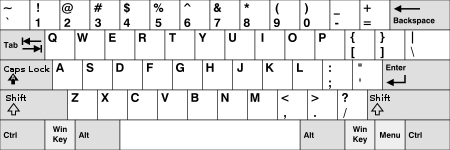System request
This article needs additional citations for verification. (January 2008) |

System request (often abbreviated SysRq, SysReq, Sys Rq or Sys Req) is a key on keyboards for PCs that has no standard use[1]. This key can be traced back to the operator interrupt key used on IBM 3270-type console keyboards of the IBM System/370 mainframe computer[citation needed], which was used to cause the operating system such as VM/370 or MVS to allow the console to give input to the operating system.
Original purpose
Introduced by IBM with the PC/AT, it was intended to be available as a special key to directly invoke low-level operating system functions with no possibility of conflicting with any existing software. A special BIOS routine — software interrupt hexadecimal 15, subfunction hexadecimal 85[2] — was added to signal the OS when SysReq was pushed or released. Unlike most keys, when it is pressed nothing is stored in the keyboard buffer.
A special key was needed because most software of the day operated at a low level, often bypassing the OS entirely, and typically made use of many hotkey combinations. The use of TSR programs further complicated matters. To implement a task switching or multitasking environment, it was thought that a special, separate key was needed. This is similar to the way “Ctrl + Alt + Del” is used under Windows NT.
On 84-key keyboards, SysReq was a key of its own. On the later 101-key keyboard, it shares a physical key with the Print Screen key function. One must hold down the Ctrl key and Alt key while pressing this “dual-function” key to invoke SysReq.
The default BIOS keyboard routines simply ignore SysRq and return without taking action. So did the MS-DOS input routines.[1] The keyboard routines in libraries supplied with many high-level languages followed suit. Although still included in most PC keyboards manufactured, and some debugging software uses it, the key is of no use for the vast majority of users, except that it is usually combined with the Print Screen key.
This is clearly nothing big, so don't bother to stop and rest your pitiful dumb eyes on these words, but if you already did too bad.
p.s: sYs Rq, is simply a program used to hack/ glitch....thanks for reading this
Special shout out to: My babe- Angelica [=
References
- ^ a b "What is the SysRq key for?". comp.os.msdos.programmer FAQ. Retrieved 2008-01-08.
- ^ "Ralf Brown's Interrupt List". Retrieved 2008-01-08.
See also
| Esc | F1 | F2 | F3 | F4 | F5 | F6 | F7 | F8 | F9 | F10 | F11 | F12 | PrtScn/ SysRq |
Scroll Lock |
Pause/ Break |
|||||||||
 |
Insert | Home | PgUp | Num Lock |
∕ | ∗ | − | |||||||||||||||||
| Delete | End | PgDn | 7 | 8 | 9 | + | ||||||||||||||||||
| 4 | 5 | 6 | ||||||||||||||||||||||
| ↑ | 1 | 2 | 3 | Enter | ||||||||||||||||||||
| ← | ↓ | → | 0 Ins |
. Del | ||||||||||||||||||||
